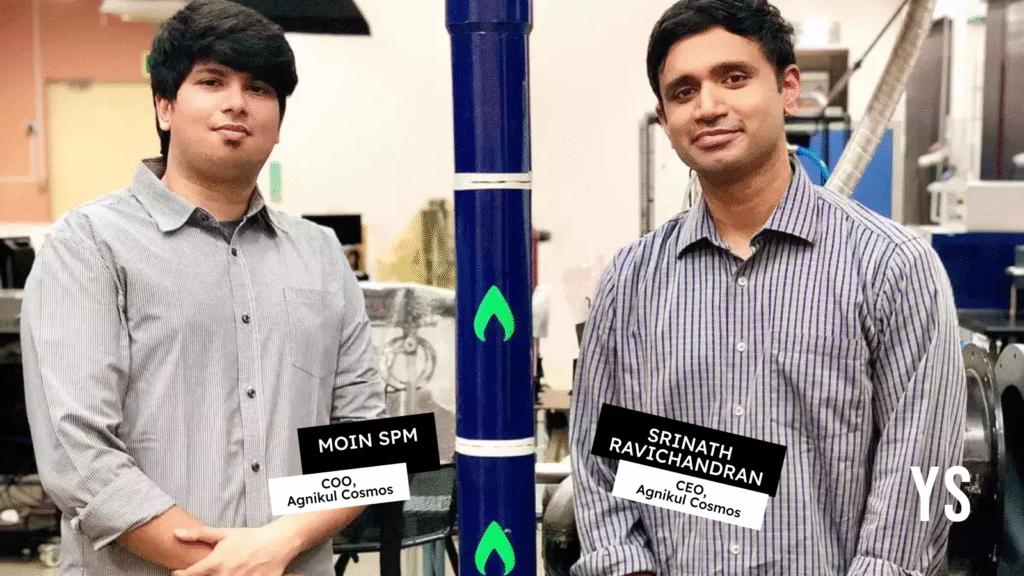
With India’s space sector booming with private players, Agnikul Cosmos is trying to set itself apart with an ambitious growth target. By 2028, the Chennai-based space tech startup aims to launch 50 rockets per year.
And, it has some mettle to its ambitions. Last year, the IIT Madras-incubated startup successfully carried out the sub-orbital test flight of the world’s first 3D-printed rocket engine, Agnilet. The semi-cryogenic engine, powered by super-cold liquid oxygen and room-temperature kerosene, lifted the Agnibaan SOrTeD rocket from the startup’s own launchpad in Sriharikota, Andhra Pradesh.
With 3D printing, Agnikul can produce a rocket engine at a much shorter timeline than conventional engineering. This aligns with the space tech startup’s mission of building a cost-efficient vehicle tailored for launching small satellites.
“Getting to space shouldn’t be the hardest part of living in or working from space,” Srinath Ravichandra, Co-founder and CEO of Agnikul Cosmos, tells YourStory in an email interview.
Building from scratch
Founded in 2017, Agnikul Cosmos is a result of a long-held dream of enabling rapid and flexible access to space. The idea emerged when Ravichandran identified a gap when living in Los Angeles—small satellites were finding it difficult to secure a ride on larger rockets, and there was a lack of smaller launch vehicles that could effectively accommodate these satellites.
Recognising the need for dedicated launch solutions, Ravichandran and Moin SPM (now also co-founder) began an extensive search for potential collaborations with professors and experts who had access to testing facilities in India.
Eventually, they gained backing from Professor Satya Chakravarthy, who headed the National Centre for Combustion Research and Development at IIT Madras. With his support, along with mentorship from RV Perumal, a retired ISRO veteran, the team built Agnilet, which was first successfully test-fired in 2021 and received a patent in 2022.
Realising low-cost launches
Agnikul employed 3D printing as a solution to achieve a cost-effective manufacturing process despite its smaller-sized systems. The space tech startup was able to build a rocket engine within three days, and reduced the number of engine parts from 14 to one.
“Making a ride to space as affordable and as accessible as a ride to any other point on our planet is what defines success for Agnikul,” states Ravichandran, emphasising Agnikul’s commitment to democratising space.
.thumbnailWrapper{
width:6.62rem !important;
}
.alsoReadTitleImage{
min-width: 81px !important;
min-height: 81px !important;
}
.alsoReadMainTitleText{
font-size: 14px !important;
line-height: 20px !important;
}
.alsoReadHeadText{
font-size: 24px !important;
line-height: 20px !important;
}
}

Agnikul also developed India’s first private launchpad in 2022. “Developing a mobile launchpad involves coming up with a completely new design for launchpad plumbing, electronics and software,” he remarks, referring to the complex systems that manage everything from fuelling to final countdowns—now designed to move wherever the rocket does.
In building a mobile launchpad, Agnikul also had to navigate several hardware and integration hurdles, such as ensuring a modular, transportable design with no hazardous substances. This meant that every component of Agnikul’s launchpad had to be carefully engineered for mobility and safety—without compromising on the precision needed to synchronise with existing national space infrastructure.
For the Agnibaan SOrTeD rocket launch, the ground systems had to function seamlessly, which wasn’t an easy task.
“We had two countdown aborts before we had a flight because of various ground system issues that could have been fixed if ground systems that participate in the countdown were held to the same standard as flight systems,” comments Ravichandran.
Getting it right
From a business standpoint, launching every two weeks would be an ideal interim target for Agnikul and would support the startup’s broader vision of enabling rapid and efficient space access. However, the company must balance quality with scale as the industry requires every component to be produced in line with quality standards. This makes it essential to develop an ecosystem of punctual and quality-conscious suppliers.
Despite the scale of the challenge, Agnikul remains confident. “We know it can be done,” Ravichandran asserts, “but this has to be solved carefully.”
Even as Agnikul scales up, sustainability remains a key focus area. While kerosene and liquid oxygen—used as propellants—are not particularly environmentally friendly, the company plans to make fuel combustion efficient and not waste “any aspect” of the system being used to reach orbit.
Furthermore, Agnikul adheres to strict de-orbiting protocols, ensuring that its rocket is de-orbited post satellite deployment if it serves no further use to the mission.
What the ecosystem needs next
Ravichandran mentions that there needs to be more awareness about the space tech sector, especially among the investor community. A message from the government backing the viability of building profitable space-tech companies would further spur investor engagement.
Additionally, awarding contracts to tech-mature startups could be a “huge boost” for the industry, he adds.
This growing optimism is reflected in India’s expanding role within the global space economy. In revenue terms, India accounted for 2.9% of the global space launch services market in 2023. It is the fastest-growing regional market within Asia-Pacific and is projected to reach $1.66 billion by 2030, according to Grand View Research.
These developments align with broader global trends. The global space launch services market is experiencing rapid growth, with strong expansion expected over the coming decade. This surge is driven by rising demand for satellite launches to support communication, navigation, and Earth observation, as well as the growing deployment of satellite constellations.
According to Research and Markets, the market is forecast to grow from $16.4 billion in 2024 to $46.1 billion by 2033, representing a robust compound annual growth rate (CAGR) of 11.28% between 2025 and 2033.
Edited by Kanishk Singh

